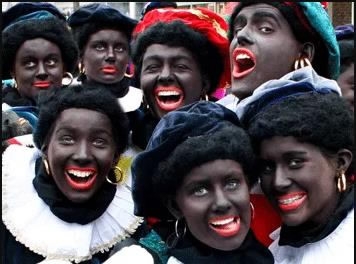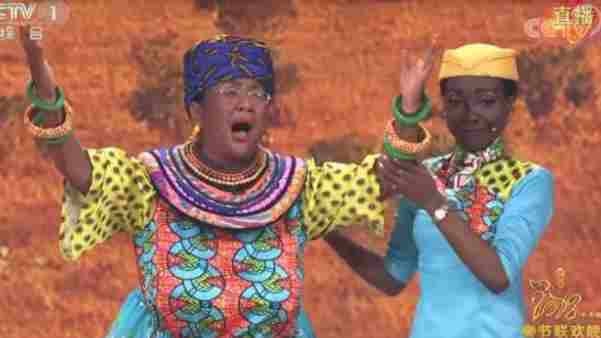The annual CCTV Spring Festival Gala was filled with its usual pageantry and delight drawing millions of viewers all across China to tune in for the spectacular star-studded phenomenon. However, one sketch from the magical show is sparking controversy on social media platforms Weibo and WeChat.
Best of intentions
The sketch was intended to highlight the importance of China’s relationship with Africa as recent years have seen growing trade, investment, and people-to-people exchanges.

A woman dressed as “Zwarte Piet” (Black Pete), the helper of Saint Nicholas, throws candy from the balcony of the City Hall at Brussels’ Grand Place December 1, 2012. / Reuters
A woman dressed as “Zwarte Piet” (Black Pete), the helper of Saint Nicholas, throws candy from the balcony of the City Hall at Brussels’ Grand Place December 1, 2012. / Reuters
What was meant to be a short humorous skit quickly turned into a heated debate online as netizens voiced their concerns over the racial overtones on display.
Is blackface offensive?
The main focus of the online discussions centered on one of the main actors in the skit who appeared to be a Chinese woman in “blackface” – “blackface” is the practice of non-black actors using black makeup to pretend to be black, often exaggerating racial differences and racial stereotypes. In this specific case, the actor also appeared to have a comically large fake bottom.
Netizens, of all races, debated the possible “offensiveness” of the skit and “blackface”. Blackface is not an issue that many Chinese are familiar with.
While some netizens simply branded the sketch as racist and others defended it as championing the importance of the links between China and African countries, it has also led to a more nuanced debate about the portrayal of Africa in China and the media more generally.

Dunkin Donuts has been heavily criticized for running this advertisement in Thailand in 2013. The ad for chocolate donuts featured a fair-skinned woman in blackface. In the television commercial, the woman turns black after eating the donut. /AP
Dunkin Donuts has been heavily criticized for running this advertisement in Thailand in 2013. The ad for chocolate donuts featured a fair-skinned woman in blackface. In the television commercial, the woman turns black after eating the donut. /AP
Mixed reaction
“Africa has long been branded with wild animals and nature. … The content was simply portraying what we always advertise to Chinese and the World to come to see,” Tanzania native Aristides Basebya told CGTN Digital.
While another, viewer felt it was worth including.
“Overall I think it's necessary even though it creates a controversy. But it pushes people to discuss and hopefully eventually something positive comes out of it,” Beijing native Yixuan Heather Li told CGTN Digital.
One of the people who worked on the sketch told CGTN Digital that a few of the actors had been nervous about the sketch and some of the racial sensitivities but had been reassured by the producers because of the intent of the positive message they were trying to get across.

Cover to an early edition of Jump Jim Crow sheet music. / University of Virginia
Cover to an early edition of Jump Jim Crow sheet music. / University of Virginia
History of blackface
So how has “blackface” become such a politically sensitive issue and what are its origins?
In medieval Europe, blackface was often used for entertainment. For example, in France and Italy, black-masked figures would act out antisocial behavior such like violence. In 19th century America, white performers would have minstrel shows in which they would put black coal on their faces and play out African American stereotypes in exaggerated costumes that ridiculed and lampooned black people. This practice continued until the 1970s.

“Black Pete”, typically played by white people in blackface, has become the focus of heated debate in the Netherlands. / Reuters
“Black Pete”, typically played by white people in blackface, has become the focus of heated debate in the Netherlands. / Reuters
Growing African presence in China
Irrespective of netizens’ personal views on the sketch what is beyond debate is the growing number of Africans in China. For example, the number of African students here in China has overtaken the number of African students studying in the US and the UK, growing from just under 2,000 to almost 50,000 in 2015.
Whether the sketch was a simple case of harmless parody or even an attempt to recognize an important issue, racial sensitivities should be taken into consideration.






